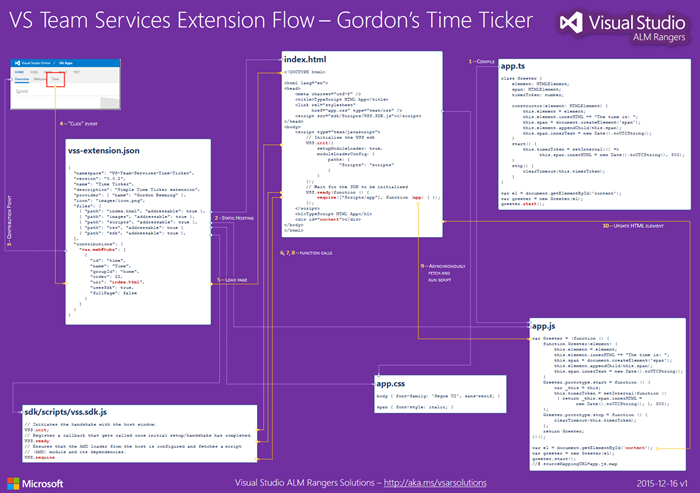Extensions 101 – Attempting to visualize the main processing flow
You, like many of us, have probably explored VS Team Services extensions by following Gordon’s A 'Hello World' for VSO Extensions blog post. This post is an attempt to visualise the flow of the sample and inject a few gems to clarify the magic behind the scenes.
- When you build your extension project, the TypeScript (typed superset of JavaScript) files are compiles to plain JavaScript.
- Host HTML, CSS and JavaScript static content on your own service, Azure or on VS Team Services directly.
- Extensions add new capabilities to VS Team Services using contributions.
- When you click on the extension point, the extension manifest defined the web page to be loaded. The example uses a hub, whereby other contributions include menu action, build task, work item extensions, etc.
- The configured web page is loaded, in this example index.html is loaded.
- VSS.init, part of the Core Client SDK,initiates the handshake with the host window. Find details on IExtensionInitializationOptions and using the new extensibility model in using TypeScript for Visual Studio Online Extensions.
- VSS.ready registers the callback that calls require. it gets called once the initial setup/handshake has completed.
- VSS.require ensures that the AMD loader from the host is configured and fetches the a script (AMD) module and its dependencies
- The app script is asynchronously loaded and run.
- In the Time Ticker the app.js JavaScript instantiates a Greeter object and calls its start function, which updates the content element with the time.
You can find a the poster shown above here.
We need your feedback!
Any other information we should add to the poster or this post?
Do you have a question, feedback, or an interest to join the early adopters? Add a comment below or ping us here.

